Lecture 18 - Population ecology: age-structured populations and life histories
1/62
There's no tags or description
Looks like no tags are added yet.
Name | Mastery | Learn | Test | Matching | Spaced |
|---|
No study sessions yet.
63 Terms
Even though lecture 17 explained that small populations have the fastest growth rate, why would denser populations be beneficial?
Because denser populations (aka. larger populations) would give species more mates to reproduce with.
For example, if you have an abundance of resources but no mate, there is no way the population can increase, let alone increase quickly.
Define allee effects.
This term refers to the negative effects of low population density on population growth rates. This could be due to lacking social benefits (ie. not being able to find a mate or missing out on the advantages of group defence/group living).
Hence, this term refers to why smaller populations may not be so beneficial like what was said in lecture 17.
What is an example of Allee effects?
Meerkats.
They cooperate to avoid predators and take care of young Meerkats and so a minimum population size is needed for them to grow. Therefore, if the population density is too small, they really struggle.
*This is an example of the benefits of group living.
What is considered an upper limit in population size?
When the population is above K (carrying capacity).
What is considered a lower limit in population size?
When the population is below K (carrying capacity).
What could happen if the population size is in the lower limit?
The allee effects may be too large and the population may not be able to grow any further.
Hence, scientists typically think that the species will go extinct.
Why is it important to understand allee effects?
Because allee effects could lead to the extinction of smaller populations.
Therefore, understanding allee effects is crucial in order to try and prevent the extinction of a certain species (aka. crucial for conservation of species).
What is something that makes exponential and logistic models less accurate?
They treat all individuals in a population the same.
For example, in those models, the birth and death rates are constant in each individual in the entire population.
However, in real life, not everyone has the same probability of giving birth or dying.
Define fecundity.
The ability to produce an abundance of offspring.
What depends on age?
Fecundity.
What are the key components of life history strategies?
the species’ lifespan
the timing of reproduction
the number of offspring
how invested parents are in their offspring
What is the typical life history for plants and animals?
They are born small
Then they grow for a period of time without reproducing in order to accumulate resources
When they have enough resources, the organism matures and starts spending resources on reproduction
Are the lifestyles of separate sexually mature species different?
Yes.
Why are the lifestyles of separate sexually mature species different?
Because some expend all their resources to reproduce all at once.
However, others will spread out their usage of resources to produce many times.
What do we need to consider in order to make our population size predictions more realistic?
Age structure.
Why do we need to consider age structure to make realistic population size projections?
This is because, if individuals tend to die at the age when they typically reproduce, this will slow down population growth by a lot more than if the mortality rate was highest when individuals were too old to reproduce.
Hence, understanding the age-structure in populations will help us understand how a population will grow.
What are some examples of variation in reproductive maturity, fecundity and lifespan amongst different species?
Elephants and humans have low fecundity, long lifespans, late 1st reproductions and high investment of resources in their offspring.
Whereas, Pika’s can have multiple litters a year (1-13), so they have a high fecundity. They also have a short lifespan (around 3-4 years) and start reproducing at the age of 1. So they have an early 1st reproduction. Lastly, they have a lower investment of resources in their offspring compared to elephants and humans.
In contrast, Salmon has a high fecundity (thousands of eggs), medium lifespan, late 1st reproduction and low investment of resources in their offspring.
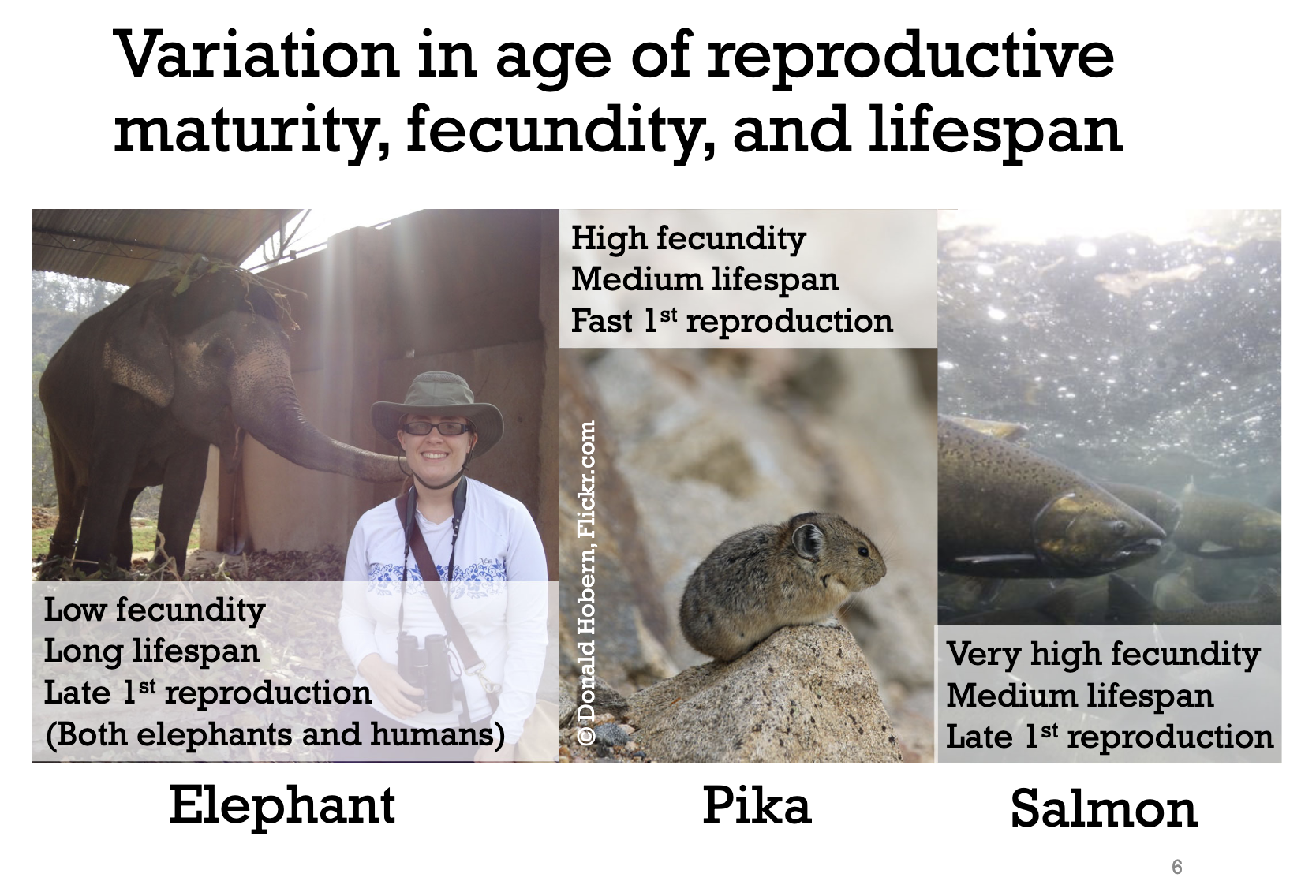
How are variation in fecundity and survivorship (aka. birth and death rates respectively) summarised?
They are summarised via life tables.
Why are life tables important?
important for understanding how life histories evolve
important in helping conserve endangered populations
to understand the changes in the structure of human populations (demography)
Why are life tables important to understand in regards to helping conserving populations?
Because a small population of old animals is at a much higher risk of extinction compared to a small population of younger animals who still have reproductive abilities.
And life tables help identify such factors since differences in fecundity and survivorship, due to age, are taken into account.
Define an age sex pyramid.
It is a graph that shows the number of individuals at a certain age in a population.

Why do ecologists usually just model females?
Ecologist think that females are the sex that invests more in populations and thus are the sex that limit population growth.
For example, eggs are larger and require more resources to make than sperm. Hence, ecologists think that there is such an abundance of ‘cheap’ sperm that it will never be a limiting factor to population growth (almost like sperm is the excess reactant, while eggs are the limiting reactant).
How is time measured in models that take age into account?
Time is measured as age-class intervals. This is an arbitrary unit of time that is specific to the organism being studied.
For example:
for mammals its years (ie. humans is 5-years)
for insects it’s weeks
for bacteria it’s minutes or hours
Define life tables.
Tables that summarise the statistically expected life events of an average individual of a specific age in a population (really just for the average female since they have been deemed as the limiting factor to population growth).
They summarise life events like…
age of death
age and timing of reproduction
How are age-classes denoted?
subscript x
How is the probability of being alive at age x denoted?
Ix
How does the probability of being alive at age x change as age increases?
Ix declines with x
What is a survivorship curve?
A graph showing the relationship between the probability of being alive at age x and age.
Ix vs. x
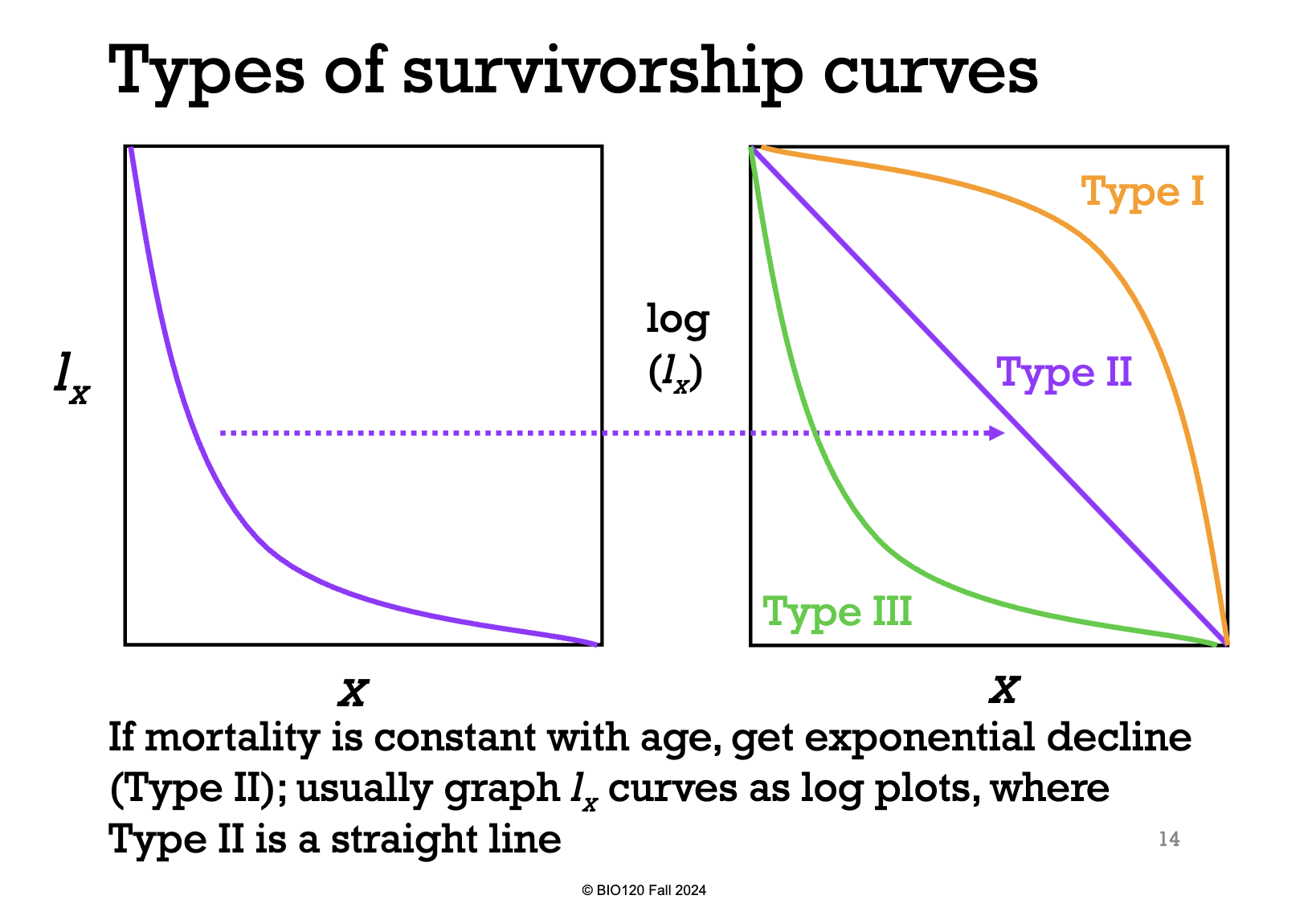
Why is I0 = 1.0
Because life tables only count babies who are alive. So the probability of being alive at age 0 is 100% in life tables.
Is the shape of a survivorship curve specific to the species being graphed?
Yes.
Define a type 2 survivorship curve?
Constant mortality rate with age.
What type of survivorship curve are humans expected to have? Why?
Type 1.
We have a lower mortality in earlier life (our health is usually better), then after a certain age, the decline in our health gets more prominent, so mortality increases dramatically.
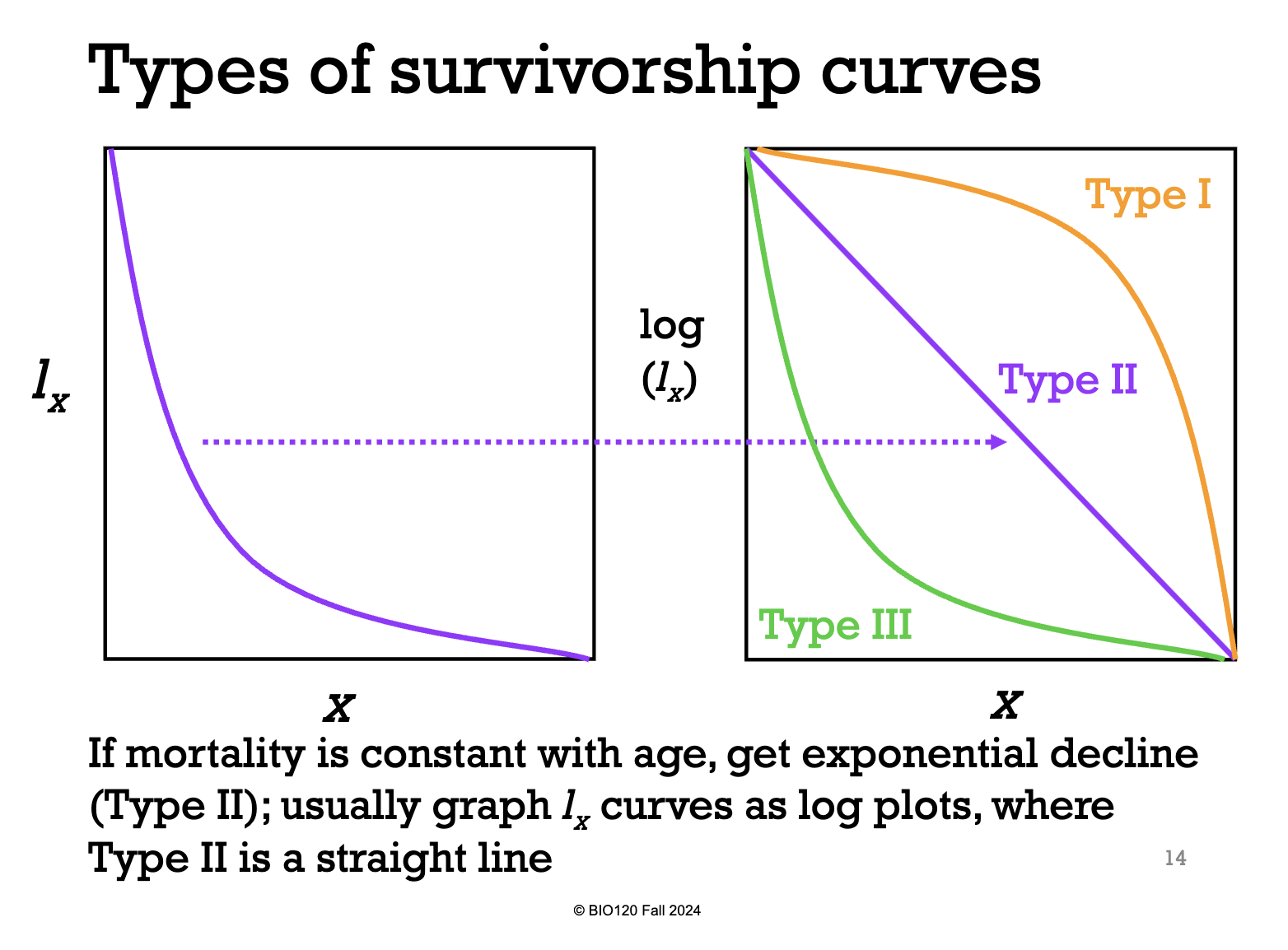
What is a type 3 survivorship curve?
When a species has a high mortality in early life. But if they can survive past that age, their mortality level becomes super low.
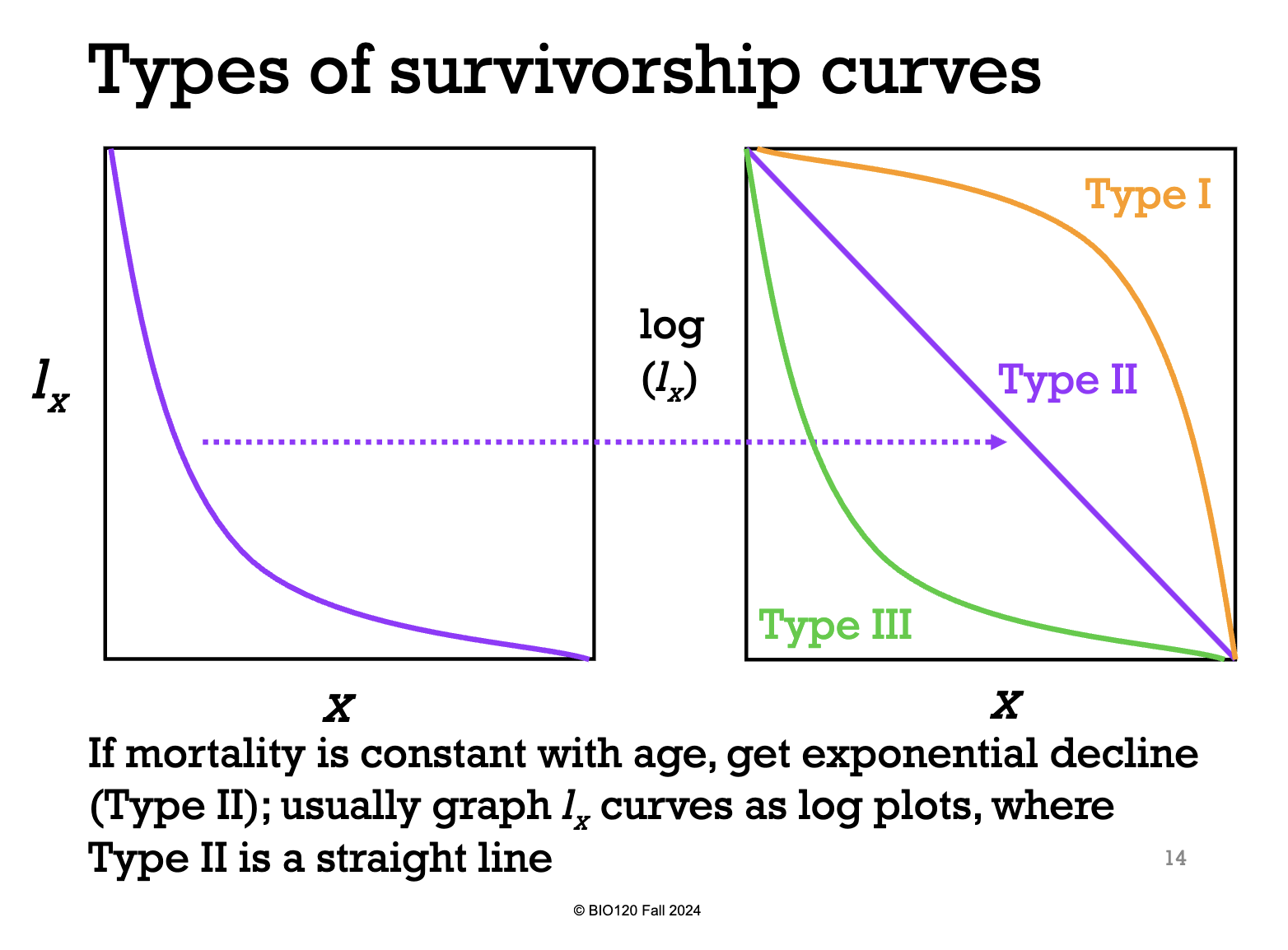
What type of species is a type 3 survivorship curve common in?
Plants and invertebrates.
This is because they make a lot of offspring but only some survive. Once they do survive though, is likely to live a long time.
What is mx or bx?
The number of daughters that a female gives birth to at age x during a certain age interval.
Is mx or bx a characteristic of a species?
Yes.
What is it called when increased fecundity reduces survivorship of an organism?
The cost of reproduction.
Why does increased fecundity reduce survivorship of an organism?
If an organism decides to use their resources to reproduce, they cannot use it for survival. This is because you can only use that resource for one thing. Hence, there is a trade-off.
Define the net reproductive rate (r0).
The average number of daughters a female will have in her lifetime.
*look at slide - very important concept
To calculate R0 you must add up the product of the “l(x) * b(x)” values across ALL the age class intervals in the life table.

How do you calculate the average age an average female gives birth?

What is the relationship between R0, λ and r?
They all represent growth rates but it’s just their time units are different.
R0 - one generation
λ - discrete unit of time
r - infinitesimally small time windows
Therefore, you can directly calculate between them.

Why do organisms of higher growth rates generally have higher fitness?
Because fitness is a measure of reproductive output and reproductive output is also the thing that drives population growth.
Therefore, we usually expect evolution by natural selection to favour higher growth rates and thus an early age of reproduction and high fecundity.
Since we think that natural selection favours early age reproduction and high fecundity, why aren’t all organisms like that?
This is because reproduction is costly. Hence, a longer pre-reproductive period can leave more time for organisms to accumulate more resources.
That’s why sometimes it’s more beneficial for an organism to wait to reproduce, rather than reproduce early.
Define the strategy iteroparity.
A reproductive strategy where an organism reproduces multiple times over in its life.
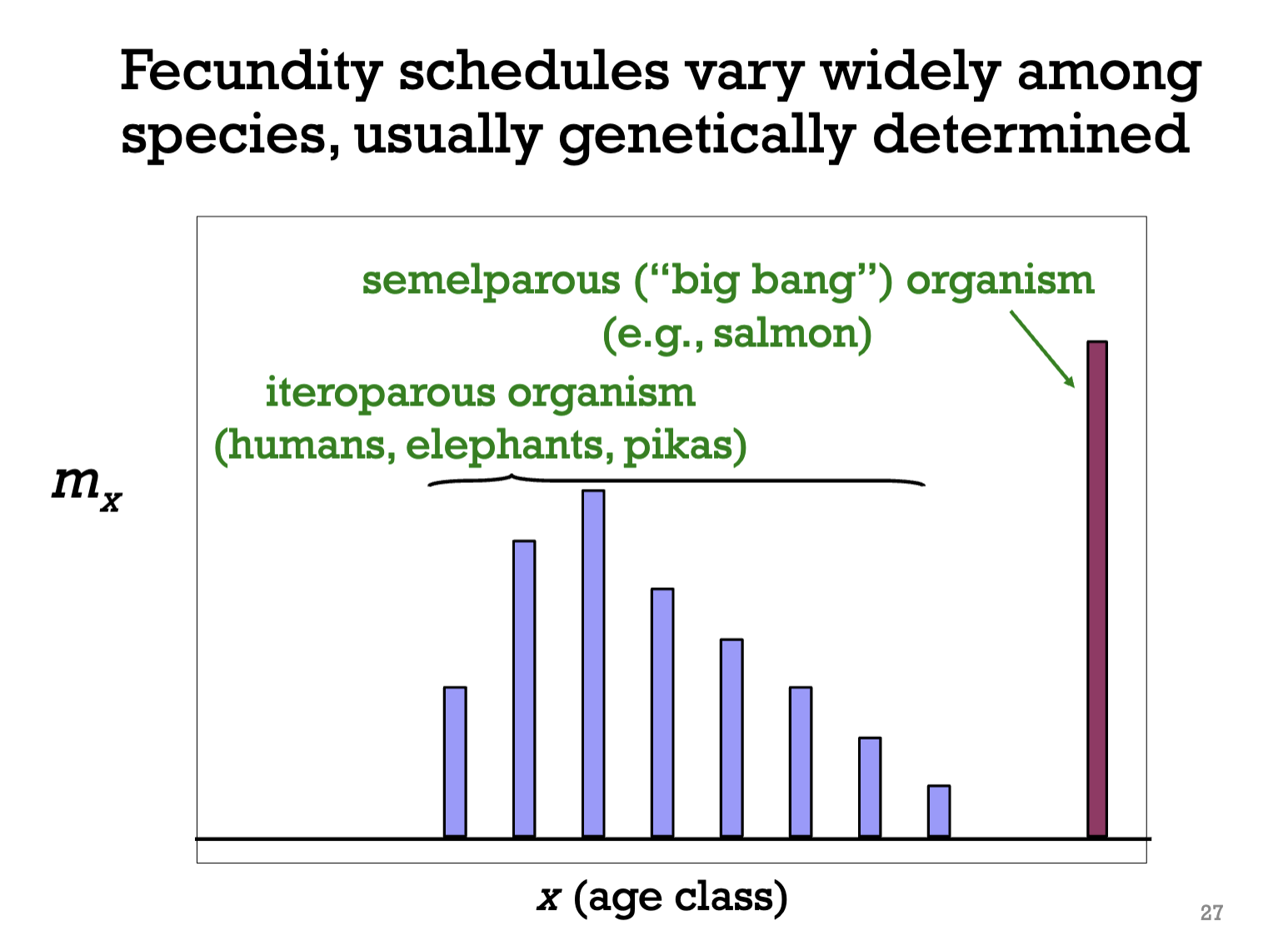
Define the strategy semelparity.
A reproductive strategy where an organism reproduces in their last year of life and then dies.
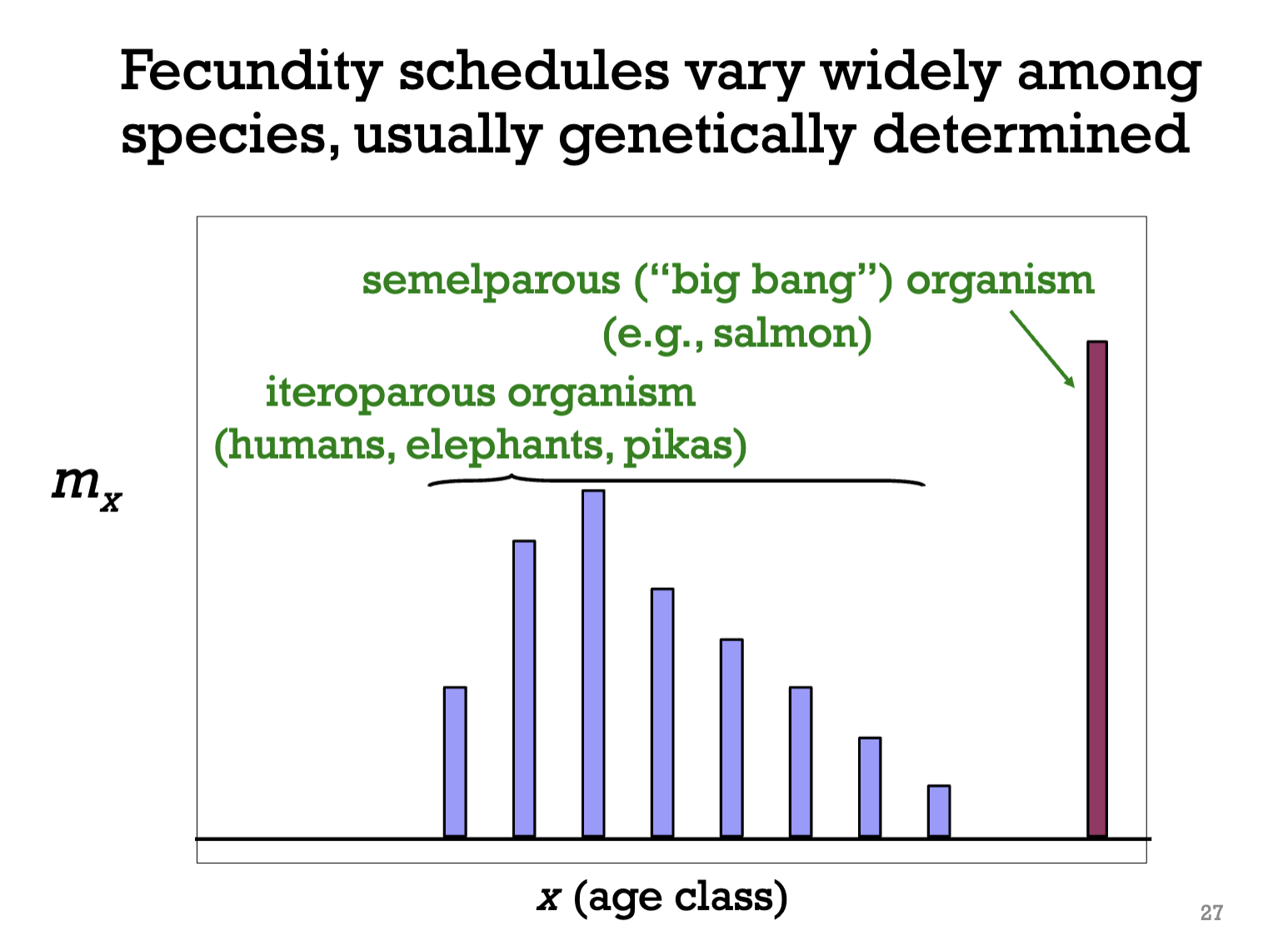
Define monocarpic.
When a plant makes flowers in one season and then dies.
Define annuals.
A plant that only lives 1 year.
*must be monocarpic because they reproduce in their one and only year of life.
Define biennials.
A plant that lives 2 years. Their first year of life is spent growing and then they reproduce in their last year of life (year 2). This makes them monocarpic.
Define monocarpic perennials.
Plants that live for many years but reproduce in their last year of life.
Define iteroparous perennials.
Plants that live for many years but reproduce multiple times in their life.
What is an example of a monocarpic perennial (semelparity)?
Agave Century Plant.
They live 100 years. They grow for 99 years of it’s life and then in it’s last year of life it flowers. Then it dies.
*has a similar life history to salmon
When does natural selection favour semelparity?
When an organism is able to produce more offspring because of being able to accumulate resources for so long.
For example:
if reproduction depends on plant size, and it takes a long time to get to an optimum size, that can favour semelparity.
if reproduction depends on making a mssive flower to attract pollinators, semelparity could be favoured.
Why are some salmon semelparous while others are iteroparous?
Some are semelparous because they wait to grow bigger so that they can lay bigger eggs (bigger eggs have a higher fitness).
However, for the iteroparous salmon, there is no connection between the size of the salmon and the fish egg size. So there’s no point in them waiting.
What is an example of seed predators selecting for semelparity in plants?
Bamboo.
Like the century plant, Bamboo is a monocarpic plant. They flower all together in a synchronised fashion in their last year of life. This ‘satiates,’ fills up the bamboo seed predators, because so many seeds are made. So they cannot possibly eat all the seeds made. Hence, the uneaten seed gets to survive into the next population.
In real life, Bamboo waits 48 years to reproduce seeds. Then rats eat the seeds and get satiated. So much seeds is made though that some seed is able to survive and avoid predation by the rats.
Can high synchronised reproduction occur in iteroparous plants too? What type of plant?
Yes. Oak trees do what Bamboo do but with acorns.
What are the 2 other strategies that organisms use for survival?
k strategy (occurs when organisms are growing near the carrying capacity)
r strategy (occurs when organisms are growing with lots of resources and a low population density)
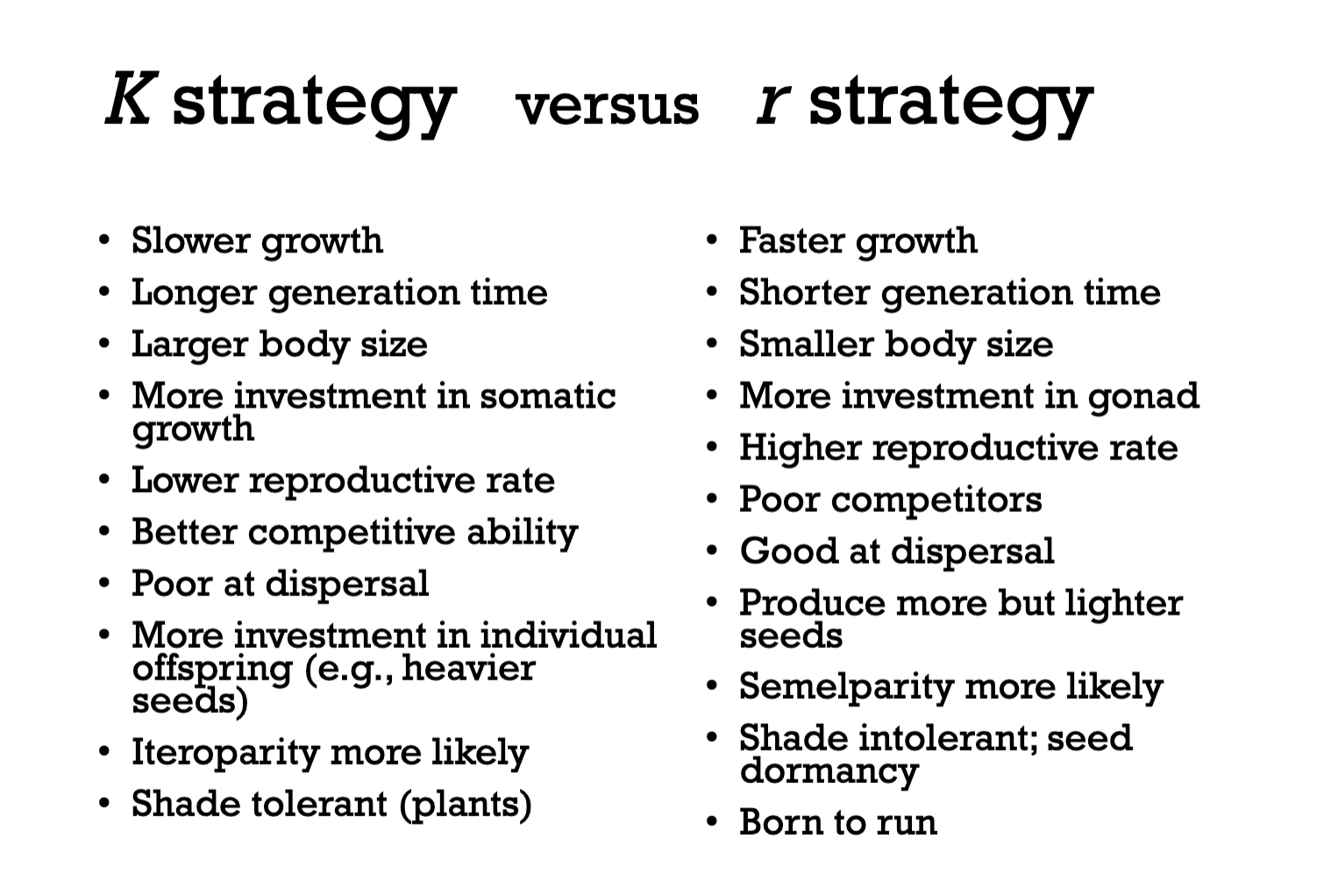
Define reproductive value (Vx).
The number of daughters an individual will have in the future.
Why is understanding reproductive value (Vx) important?
It is important because it helps determine how natural selection acts on behaviour.
It is important for ‘captive breeding and release’ programs.
Why is reproductive value important in regards to natural selection?
Animals usually want to mate with animals that have a high reproductive value. This is because that means the male will likely have greater reproductive success or fitness.
Why is reproductive value important for captive breeding and release programs?
The people running those programs want to try and release the animals with the highest reproductive value. Because that will encourage the most rapid population growth in the wild.
What does the relationship between reproductive value and age class in humans look like?

Why is reproductive value lower at birth than in humans’ late teen years?
It’s because reproduction for the individual is still very far away and the individual might die before it reaches sexual maturity. Therefore, the reproductive value is lowered to account for the possibility that the individual might die before it reproduces.
Why is reproductive value highest in human’s in their late teens?
The individual still has all the reproduction ahead of them in life.
They have been able to reach reproductive maturity (they didn’t die before reaching reproductive maturity).